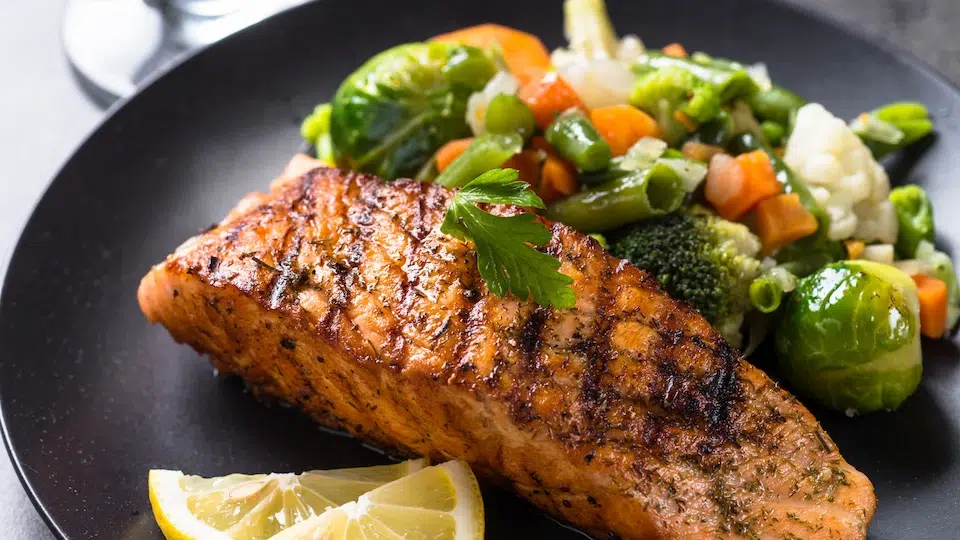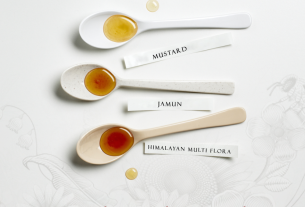Do you love indulging in a delicious salmon dish but hate the thought of wasting leftovers?
Well, fret no more!
In this article, we’re going to delve into the fascinating world of reheating salmon.
Discover the safest and most effective methods to ensure your leftover salmon maintains its mouthwatering flavors, all while preventing any risks of dryness or bacteria.
And as an added treat, we’ll even unveil a special discount code for a convenient salmon delivery service.
So, let’s dive in and unlock the secrets to perfectly reheated salmon!
reheating salmon
To reheat salmon, it is best to avoid using the microwave as it can dry it out and create a fishy aroma.
Instead, try adding moisture with olive oil or lemon to preserve the flavor.
The recommended method for reheating salmon is to use the oven at 300 degrees for 15 minutes.
Covering the salmon with foil while reheating will help prevent it from drying out or burning.
Leftover salmon can also be used in various recipes such as fish salad or mixed with avocado or mayo.
It is safe to store cooked salmon in the fridge for up to three days if it was fresh to begin with and handled properly.
Remember to cool the salmon to room temperature before storing to prevent mold and bacteria formation, and put it in the fridge within two hours of cooking to prevent bacterial growth.
It is important to store the salmon in an airtight container or wrapped in plastic wrap and aluminum foil to maintain freshness.
Key Points:
- Avoid using the microwave to reheat salmon to prevent drying it out and creating a fishy aroma.
- Add moisture with olive oil or lemon to preserve the flavor when reheating.
- Reheat salmon in the oven at 300 degrees for 15 minutes.
- Prevent drying out or burning by covering the salmon with foil while reheating.
- Leftover salmon can be used in various recipes such as fish salad or with avocado or mayo.
- Store cooked salmon in the fridge for up to three days, cooling it to room temperature and putting it in the fridge within two hours of cooking. Use an airtight container or wrap it to maintain freshness.
reheating salmon – Watch Video


Pro Tips:
1. Reheating salmon in the microwave might seem convenient, but did you know that doing so can actually result in an unpleasant fishy smell? This happens due to compounds called trimethylamine N-oxide (TMAO) breaking down when heated, releasing an odor similar to ammonia.
2. If you’re reheating salmon in the oven, one handy tip to prevent it from drying out is to place a small dish of water next to it. The steam produced will help retain moisture and ensure your salmon stays tender and juicy.
3. Salmon is known for its high omega-3 fatty acid content, but reheating it improperly can lead to some of these healthy fats being destroyed. To preserve those essential nutrients, it is best to reheat salmon gently and avoid overheating.
4. Have you ever wondered why reheated salmon can sometimes taste slightly different than when it was freshly cooked? This occurs due to the breakdown of proteins during the reheating process, resulting in a slightly altered flavor profile.
5. If you’re reheating salmon from a leftover fillet, it’s important to note that the reheating time will depend on the thickness of the fillet. As a general rule, larger and thicker pieces will require more reheating time to reach the desired temperature, so it’s essential to ensure thorough heating for food safety.
Reheating Salmon In The Microwave
Reheating leftover salmon can be a challenge. While using a microwave might seem like a convenient option, it often results in dried-out fish with an unpleasant fishy aroma. Microwaving fish tends to distribute heat unevenly, leading to overcooked edges and undercooked centers. Additionally, the high heat can cause the natural oils in the salmon to evaporate, resulting in a less flavorful dish.
To avoid these pitfalls and properly enjoy your leftover salmon, consider the following tips:
-
Use the oven or stovetop: Reheating the salmon in an oven or on a stovetop allows for more even heating and helps to maintain the moisture and texture of the fish.
-
Cover it up: When using the oven or stovetop, cover the salmon with aluminum foil or a lid to prevent it from drying out. This will help seal in the moisture and keep the fish juicy.
-
Add a splash of liquid: To further enhance the flavor and moisture of the salmon, consider adding a splash of liquid such as broth, lemon juice, or white wine before reheating. This can help prevent the fish from becoming too dry during the reheating process.
-
Reheat gently: Avoid applying high heat when reheating salmon. Instead, opt for lower heat settings and extend the reheating time to ensure that the fish is heated thoroughly without losing its moisture and tenderness.
By following these tips, you can successfully reheat leftover salmon without sacrificing its quality and taste.
“Reheating leftover salmon can be a challenge. While using a microwave might seem like a convenient option, it often results in dried-out fish with an unpleasant fishy aroma. Microwaving fish tends to distribute heat unevenly, leading to overcooked edges and undercooked centers. Additionally, the high heat can cause the natural oils in the salmon to evaporate, resulting in a less flavorful dish.“
- Use the oven or stovetop
- Cover it up
- Add a splash of liquid
- Reheat gently
Avoiding The Fishy Aroma In Reheated Salmon
To avoid the fishy aroma when reheating salmon, it is best to choose alternative methods.
One effective way to prevent this unpleasant smell is by adding moisture. Drizzling olive oil or lemon juice over the salmon before reheating helps retain its moisture and enhances the flavor.
The oil or lemon acts as a protective barrier, preventing the fish from drying out and losing its taste.
- Choose alternative methods to avoid fishy aroma
- Add moisture by drizzling olive oil or lemon juice
- Oil or lemon acts as a protective barrier to retain moisture and flavor
Adding Moisture To Preserve Flavor
Adding moisture to reheated salmon is crucial for preserving its flavor and texture. By drizzling olive oil or lemon juice over the fish, you can prevent it from drying out. Olive oil not only helps retain moisture but also adds a rich, nutty flavor to the salmon. Similarly, lemon juice imparts a tangy and refreshing taste, elevating the overall dining experience. Remember to brush the oil or lemon juice evenly over the surface of the fish before reheating for the best results.
Recommended Oven Temperature And Time For Reheating
When it comes to reheating salmon, the oven is often the preferred method. It allows for a more controlled and even heat distribution, ensuring that the salmon retains its moisture and doesn’t dry out.
To reheat salmon in the oven, follow these steps:
- Preheat the oven to 300 degrees Fahrenheit (150 degrees Celsius).
- Place the salmon on a baking sheet.
- Cook for approximately 15 minutes or until the salmon reaches an internal temperature of 145 degrees Fahrenheit (63 degrees Celsius).
Using this method, you can enjoy perfectly reheated salmon that is still moist and flavorful.
Preventing Drying Out And Burning With Foil Cover
To improve the reheating process, it is essential to cover the salmon with foil. This simple technique prevents the fish from drying out and burning around the edges. The foil acts as a shield, trapping in steam and moisture, resulting in a tender and succulent reheated salmon. Be sure to cover the entire surface of the salmon with the foil, ensuring it is tightly sealed to avoid any moisture from escaping.
Repurposing Leftover Salmon In Various Recipes
Leftover salmon can be repurposed into delicious dishes using these creative ideas:
-
Fish salad: Mix the leftover salmon with fresh greens, herbs, and a tangy dressing for a refreshing and healthy meal.
-
Salmon spread: Combine the flaked salmon with avocado and mayo to create a flavorful spread that can be used in sandwiches or wraps.
The versatility of salmon offers the opportunity to explore different recipes and enjoy its distinct taste in new and exciting ways.
“Leftover salmon can be transformed into delightful dishes with a little creativity.”
Concerns About Contamination And Spoilage Of Leftover Cooked Fish
Fish, including salmon, is a popular protein source. However, concerns about contamination and spoilage often lead to the wastage of leftover cooked fish. People worry about bacterial growth and food poisoning, causing them to throw cooked fish away. While these concerns are valid, proper precautions and procedures can help ensure the safety of storing and consuming cooked salmon.
To address these concerns and prevent wastage, here are some important guidelines to follow:
-
Refrigeration: After cooking salmon, it should be promptly refrigerated at or below 40°F (4°C) to slow down bacterial growth and prevent spoilage. Store the cooked fish in an airtight container to maintain its freshness.
-
Consume within a few days: Cooked salmon should be eaten within 3-4 days of refrigeration. In this timeframe, it is typically safe to consume as long as it has been stored properly.
-
Proper reheating: If you have leftover cooked salmon, ensure it is reheated to an internal temperature of 165°F (74°C) before consuming. This kills any harmful bacteria that may have developed during refrigeration.
-
Visual and olfactory inspection: Before consuming cooked salmon, conduct a visual and olfactory inspection. If it appears or smells off, it is best to err on the side of caution and discard it.
Remember, these guidelines are not limited to salmon and can be applied to other cooked fish as well.
In conclusion, by following proper storage and reheating practices, concerns about contamination and spoilage of cooked salmon can be effectively mitigated. Don’t let the fear of food wastage stop you from enjoying the deliciousness of leftover fish!
- To ensure the safety of storing and consuming cooked salmon, it is important to take proper precautions and procedures.
- Cooked salmon should be promptly refrigerated at or below 40°F (4°C) to slow down bacterial growth and spoilage.
- Consume cooked salmon within 3-4 days of refrigeration.
- Reheat cooked salmon to an internal temperature of 165°F (74°C) before consuming.
- Conduct a visual and olfactory inspection before consuming cooked salmon.
- These guidelines can also be applied to other cooked fish.
Safe Storage Of Cooked Fish In The Fridge
Storing cooked salmon in the fridge is safe with proper handling and storage techniques. Once the salmon has been cooked, it should be cooled to room temperature before placing it in the refrigerator. This helps prevent mold and bacteria formation. It is advisable to put the cooked salmon in the fridge within two hours of cooking to minimize the risk of bacterial growth. To maintain freshness, store the salmon in an airtight container or wrap it tightly in plastic wrap and aluminum foil.
Duration Of Fridge Storage For Cooked Salmon
If the cooked salmon was fresh to begin with and handled properly, it can be stored in the refrigerator for up to three days. However, it is important to note that refrigerating leftovers only slows down bacterial growth; it does not stop it entirely. Therefore, it is crucial to consume or cook the leftover salmon again within three days to minimize the risk of food poisoning.
Preventing Mold And Bacteria Formation In Stored Salmon
To prevent mold and bacteria formation in stored salmon, it is essential to follow specific guidelines. First, make sure to cool the cooked salmon to room temperature before refrigerating it. This will prevent the moisture on the surface from creating an environment conducive to mold and bacteria growth. Additionally, storing the salmon in the bottom drawer of the fridge, which is usually the coldest spot, helps maintain its freshness for a longer duration. Remember to label and date the container to keep track of its freshness.
Reheating salmon can be a challenging task, but not impossible. Avoid reheating in the microwave as it dries out the fish and creates a fishy aroma. Instead, try using the oven at a recommended temperature of 300 degrees Fahrenheit for 15 minutes. Covering the salmon with foil prevents drying out and burning. To preserve flavor, add moisture with olive oil or lemon. Leftover salmon can be repurposed into various delicious recipes. When storing cooked fish in the fridge, follow proper precautions and procedures outlined above. By understanding and implementing these safe tips, you can enjoy reheated salmon without any concerns about contamination or spoilage.

You may need to know these questions about reheating salmon
Is it OK to reheat cooked salmon?
Reheating cooked salmon is perfectly fine given the right approach. Salmon is a delicate fish that can easily dry out, so it is important to avoid high heat methods. Options such as using an air fryer, grill, microwave, stovetop, or steaming at low heat are recommended to maintain the fish’s moist texture. High heat can lead to the salmon becoming tough and dry, so it’s best to be cautious to preserve its delicious flavor and tenderness.
How do you reheat leftover salmon?
To reheat leftover salmon, it is important to take your time and not rush the process. Start by preheating the oven to 300 degrees. Place the salmon fillet in the oven and allow it to heat for approximately 15 minutes. The key is to cook it at a lower temperature and for a longer duration to ensure it retains its juiciness and flavor.
Can you cook salmon and eat it the next day?
Yes, it is safe to cook salmon and eat it the next day as long as it has been properly stored in the refrigerator within the recommended timeframe. Salmon, when stored correctly, can still be a flavorful and nutritious option for your next meal. However, it is important to make sure you consume the leftovers within a few days to avoid any potential risks of food poisoning associated with bacterial growth.
Do you have to reheat salmon to eat it?
While reheating salmon can certainly enhance its flavors, it is not a requirement to enjoy this delectable fish. The strong taste of salmon remains intact even when consumed cold, making it a versatile ingredient that pairs well with crunchy vegetables and tangy dressings. Whether it was cooked with spices, marinades, or sauces, the flavor profile of the salmon is well-preserved, and the manner in which it was prepared further contributes to its taste.
Reference source
https://www.thekitchn.com/5-mistakes-to-avoid-when-reheating-salmon-230418
https://www.evolvingtable.com/how-to-reheat-salmon/
https://bluglacier.com/how-to-reheat-salmon-like-a-chef/
https://oshensalmon.com/blogs/news/how-long-is-cooked-salmon-good-for-in-the-fridge



